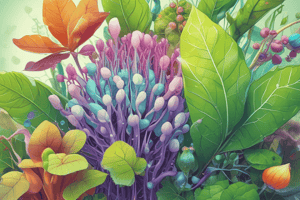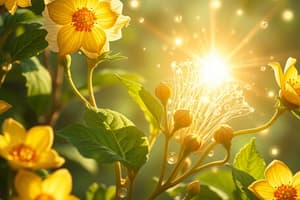Podcast
Questions and Answers
Two _______________________ cooperate in the light reactions.
Two _______________________ cooperate in the light reactions.
photosystems
Photons excite electrons in the _______________________ of the first photosystem.
Photons excite electrons in the _______________________ of the first photosystem.
chlorophyll
This is the step that releases _______________________ during photosynthesis.
This is the step that releases _______________________ during photosynthesis.
O2
The chloroplast uses the energy released by this electron “fall” to make _______________________.
The chloroplast uses the energy released by this electron “fall” to make _______________________.
The second photosystem transfers its light excited electrons to _______________________, converting it to NADPH.
The second photosystem transfers its light excited electrons to _______________________, converting it to NADPH.
Within the _______________________ (fluid) of the chloroplast, carbon dioxide from the air and ATP and NADPH produced during the light reactions are used to produce G3P.
Within the _______________________ (fluid) of the chloroplast, carbon dioxide from the air and ATP and NADPH produced during the light reactions are used to produce G3P.
The Calvin cycle is the actual sugar _______________________ machinery.
The Calvin cycle is the actual sugar _______________________ machinery.
This process is called a cycle because its starting material is _______________________.
This process is called a cycle because its starting material is _______________________.
The type of plants that have no phloem or xylem tubes are called ______ plants.
The type of plants that have no phloem or xylem tubes are called ______ plants.
A type of plant that reproduces by spores is the ______.
A type of plant that reproduces by spores is the ______.
Plants that reproduce by seeds, not spores, are classified as ______ plants.
Plants that reproduce by seeds, not spores, are classified as ______ plants.
The plant organ responsible for transporting nutrients to the leaves is the ______.
The plant organ responsible for transporting nutrients to the leaves is the ______.
The ______ is the vascular tissue that delivers products of photosynthesis from leaves.
The ______ is the vascular tissue that delivers products of photosynthesis from leaves.
The type of tropism that involves growth towards light is ______.
The type of tropism that involves growth towards light is ______.
Invertebrates, which include sponges, belong to the ______ kingdom.
Invertebrates, which include sponges, belong to the ______ kingdom.
The phylum that includes sponges is ______.
The phylum that includes sponges is ______.
Nucleotides are joined together by ______ bonds between the sugar of one nucleotide and the phosphate of the next.
Nucleotides are joined together by ______ bonds between the sugar of one nucleotide and the phosphate of the next.
The sugar-phosphate-sugar-phosphate pattern is known as a ______ backbone.
The sugar-phosphate-sugar-phosphate pattern is known as a ______ backbone.
Each nucleotide consists of three components: a ______ base, a sugar, and a phosphate group.
Each nucleotide consists of three components: a ______ base, a sugar, and a phosphate group.
The four nucleotides found in DNA differ only in their ______ bases.
The four nucleotides found in DNA differ only in their ______ bases.
Thymine (T) and cytosine (C) are ______-ring structures.
Thymine (T) and cytosine (C) are ______-ring structures.
The full name for DNA is deoxyribonucleic acid, with ______ referring to DNA’s location in the nuclei of eukaryotic cells.
The full name for DNA is deoxyribonucleic acid, with ______ referring to DNA’s location in the nuclei of eukaryotic cells.
Watson and Crick worked out the three-dimensional structure of DNA: two ______ strands wrapped around each other in a double helix.
Watson and Crick worked out the three-dimensional structure of DNA: two ______ strands wrapped around each other in a double helix.
Hydrogen bonds between ______ hold the strands together.
Hydrogen bonds between ______ hold the strands together.
Phylum Cnidaria have tentacles with ______ cells in their tips for preying
Phylum Cnidaria have tentacles with ______ cells in their tips for preying
Phylum Platyhelminthes lack any ______ or circulatory systems
Phylum Platyhelminthes lack any ______ or circulatory systems
Phylum Annelida, also known as ______ Worms, include earthworm and leech
Phylum Annelida, also known as ______ Worms, include earthworm and leech
Phylum Mollusca are invertebrates with soft ______ bodies
Phylum Mollusca are invertebrates with soft ______ bodies
Phylum Arthropoda have ______ legs and an exoskeleton
Phylum Arthropoda have ______ legs and an exoskeleton
Class Insecta, a class of Phylum Arthropoda, have ______ legs
Class Insecta, a class of Phylum Arthropoda, have ______ legs
Phylum Echinodermata include ______ and sea urchin
Phylum Echinodermata include ______ and sea urchin
Vertebrates are characterized by the presence of ______
Vertebrates are characterized by the presence of ______
Commensalism is a relationship in which one species _______________________ while the other species is not affected.
Commensalism is a relationship in which one species _______________________ while the other species is not affected.
In a mutualistic relationship, both species _______________________ from each other.
In a mutualistic relationship, both species _______________________ from each other.
The organ system responsible for food processing is the _______________________ system.
The organ system responsible for food processing is the _______________________ system.
The heart, blood vessels, and blood are components of the _______________________ system.
The heart, blood vessels, and blood are components of the _______________________ system.
The lungs, trachea, and other breathing tubes are parts of the _______________________ system.
The lungs, trachea, and other breathing tubes are parts of the _______________________ system.
The organ system that helps the body defend against infections and diseases is the immune and _______________________ system.
The organ system that helps the body defend against infections and diseases is the immune and _______________________ system.
The excretory system is responsible for the disposal of _______________________ wastes.
The excretory system is responsible for the disposal of _______________________ wastes.
The pituitary, thyroid, and adrenal glands are all part of the _______________________ system.
The pituitary, thyroid, and adrenal glands are all part of the _______________________ system.
Study Notes
Photosynthesis
- Two photosystems cooperate in the light reactions to produce ATP and NADPH.
- The first photosystem extracts electrons from water, releasing O2 during photosynthesis.
- The energy from the "electron fall" is used to make ATP.
- The second photosystem converts NADP+ to NADPH.
The Calvin Cycle
- The Calvin cycle is a process that produces G3P, an energy-rich sugar molecule, using CO2, ATP, and NADPH.
- The cycle is a sugar manufacturing process that regenerates its starting material.
- Each turn of the cycle has chemical inputs and outputs.
Plant Classification
- Non-vascular plants: lack phloem and xylem, reproduce by spores, examples include algae and bryophytes.
- Vascular plants: have phloem and xylem, reproduce by seeds, examples include pteridophytes, gymnosperms, and angiosperms.
Plant Organs
- Roots: anchor the plant, absorb water and nutrients from the soil.
- Stem: transport nutrients to the leaves.
- Xylem: vascular tissue that delivers nutrients up from the root.
- Phloem: vascular tissue that delivers products of photosynthesis from leaves.
- Leaves: where plants manufacture their food.
- Stomata: tiny pores on leaf surfaces that allow substances to be absorbed into the plant.
- Flowers: the reproductive organ of plants.
Tropisms in Plants
- Tropism: growth toward or away from a stimulus.
- Examples of tropisms include phototropism (to light), geotropism (to gravity), thigmotropism (to touch), and hydrotropism (to moisture).
Animal Kingdom
- Invertebrates: lack a backbone, examples include porifera, cnidaria, platyhelminthes, nematoda, annelida, mollusca, and arthropoda.
- Vertebrates: have a backbone, examples include cold-blooded vertebrates (poikilothermic/ectothermic) and warm-blooded vertebrates (endothermic).
DNA and RNA
- DNA: deoxyribonucleic acid, contains deoxyribose sugar, and has the bases adenine (A), guanine (G), cytosine (C), and thymine (T).
- RNA: ribonucleic acid, contains ribose sugar, and has the bases adenine (A), guanine (G), cytosine (C), and uracil (U).
- Watson and Crick discovered the double helix structure of DNA, with two polynucleotide strands wrapped around each other.
Organ Systems in Humans
- Digestive system: mouth, pharynx, esophagus, stomach, intestines, liver, pancreas, anus; main functions include food processing and elimination.
- Circulatory system: heart, blood vessels, blood; main function is internal distribution of materials.
- Respiratory system: lungs, trachea, other breathing tubes; main function is gas exchange.
- Immune and lymphatic system: bone marrow, lymph nodes, thymus, spleen, lymph vessels; main function is body defense.
- Excretory system: kidneys, ureters, urinary bladder, urethra; main function is disposal of metabolic wastes and regulation of osmotic balance.
- Endocrine system: pituitary, thyroid, pancreas, adrenal, and other hormone-secreting glands; main function is coordination of body activities.
Studying That Suits You
Use AI to generate personalized quizzes and flashcards to suit your learning preferences.
Description
This quiz covers the energy flow during the photosynthesis process, including the cooperation of two photosystems and the role of photons, electrons, and water.




